Hypatia of Alexandria: Defender of Reason
by Jim Haldenwang
written April 7, 2008
revised July 28, 2012
Who was Hypatia? She was the last great Greek teacher, philosopher, mathematician, and scientist of antiquity. She devoted her life to defending and preserving the great Greek tradition of rational thought. Her cruel murder in 415 AD marked the end of humanity's first Age of Reason and the beginning of the Dark Ages. Her life's work may have helped to spark the Renaissance and the second Age of Reason. Here I present what little is known of her life, and why she may have been one of history's most influential figures.
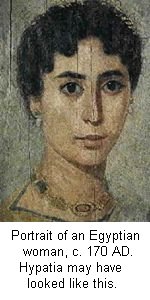
The 5th century Christian historian Socrates Scholasticus (c. 379 – c. 450 AD) said of Hypatia, "There was a woman at Alexandria named Hypatia, daughter of the philosopher Theon, who made such attainments in literature and science, as to far surpass all the philosophers of her own time." [1]
Theon (c. 335 – c. 405 AD), Hypatia's father, was
the last recorded scholar-member of what still remained of the great Library
of Alexandria. The Library of Alexandria was the greatest repository
of knowledge in the ancient world. For six centuries prior to Hypatia's
birth, the finest intellectuals of the Western world made their home in
Alexandria and studied at the great Library. The Library was probably
established in the third century BC, during the reign of Ptolemy II of
Egypt (281 BC – 246 BC). The Library probably contained over half
a million scrolls. It is possible that much of this collection was
lost in a fire when Julius Caesar conquered Alexandria in 48 BC.
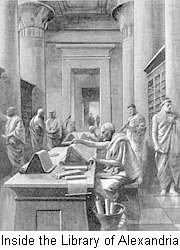 There is a legend that the collection was partially restored by Marcus
Antonius (Mark Antony), who plundered the Library of Pergamon (the second
largest library of the ancient world) in order to present a wedding gift
of over 200,000 scrolls to Cleopatra. Whether or not this story is
true, it appears that the collection at Alexandria decreased over the centuries,
due to fires and the wear and tear of age.
By the time of Theon, who lived in the 4th century AD, the only
surviving building of the Library complex may have been the "Mouseion"
or Museum (the "Temple of the Muses," from which we get the modern word
"museum.") The Museum appears to have been a research institute,
perhaps the world's first. It was in the Museum where Theon probably
worked as a distinguished mathematician and scholar.
There is a legend that the collection was partially restored by Marcus
Antonius (Mark Antony), who plundered the Library of Pergamon (the second
largest library of the ancient world) in order to present a wedding gift
of over 200,000 scrolls to Cleopatra. Whether or not this story is
true, it appears that the collection at Alexandria decreased over the centuries,
due to fires and the wear and tear of age.
By the time of Theon, who lived in the 4th century AD, the only
surviving building of the Library complex may have been the "Mouseion"
or Museum (the "Temple of the Muses," from which we get the modern word
"museum.") The Museum appears to have been a research institute,
perhaps the world's first. It was in the Museum where Theon probably
worked as a distinguished mathematician and scholar.
It is not known exactly when Hypatia was born. The dates commonly given are between 350 and 370 AD. [2] It appears her father gave her an enlightened education, which may have included trips to Athens and Italy to study. When she grew up, she far surpassed her father and became the world's foremost teacher and scholar, working in the fields of mathematics, astronomy, mechanics, and philosophy. [3] She became the head of the Neoplatonist school of philosophy around 400 AD. Students came from throughout the known world to be taught by her. Her renown was such that she was able to move freely in a world dominated almost exclusively by men. In the world's first reference to a hydrometer, an instrument used to measure the specific gravity of fluids, her pupil, the bishop Synesius of Cyrene (c. 373 – c. 414), wrote her a letter asking her to make one for him. [4] She also helped Synesius to construct an astrolabe, an instrument used to measure the position of the Sun and stars. [5]
She wrote extensively, but most of her writings have been lost, or at least the acknowledgments to her have been lost. [6] She and her father worked together to write commentaries on important texts, such as Ptolemy's Almagest. These commentaries, known as recensions, were very extensive and amounted to complete revisions of the original works. We know that father and daughter worked together because in Theon's commentary on Book III of Ptolemy's Almagest, he tells us that the work is "in the recension of my philosopher-daughter Hypatia." [7] She was known for her eloquent style and her ability to simplify and clarify complex concepts. [8] Indeed, her father seems to have considered Hypatia his superior in this regard.
Although modern historians often credit Theon for an important recension of Euclid's Elements, [9] it is reasonable to hypothesize that Hypatia was also involved. The extraordinary eloquence and clarity of the Elements that has been handed down to us suggests the hand of Hypatia. As Theon's comment on Book III of Ptolemy's Almagest mentioned above shows, Hypatia modestly did not take credit for her own work. In this paper I will refer to this edition of the Elements as the recension of Theon and Hypatia. This recension survived the Dark Ages and re-emerged in Europe a thousand years later. How did this happen? The Neoplatonist philosopher Proclus (412 – 485) probably made use of the recension of Theon and Hypatia when he added his own commentary to Book I. Proclus resided in Athens. After the School of Athens was shut down by the emperor Justinian in 529 AD, the surviving Greek recensions, including the Elements, made their way to Byzantium. In Byzantium, the Greek works were translated into Arabic around 800 AD. The Arabic version of the Elements was translated into Latin in the 12th century, and then spread throughout Europe over the next few centuries.
How important was the survival of Euclid's Elements to the course of human history? The Elements was the most influential textbook in history. [10] As reformulated by Theon and Hypatia, the Elements became more than just a textbook on geometry. It became the definitive guide on how to think clearly and reason logically. The scientists Copernicus, Kepler, Galileo and Newton were all influenced by the Elements. Newton's interest in mathematics was awakened when he bought and read a copy of this book. [11] He used the style of the Elements, with formal propositions and rigorous proofs, in his Principia, the book which forms the foundation of modern physics. All of modern mathematics employs the logical, deductive method that was introduced by the Elements. In short, modern science and technology rests on the firm foundation laid down by Euclid's Elements.
Hypatia lived in turbulent times. It was the twilight of the Hellenistic era and the dawning of the Age of Faith. The Christians were the rising power, and the concept of the separation of church and state did not exist at that time. In 391 AD, the Christian emperor Theodosius I ordered the destruction of all pagan temples. In Alexandria, the bishop Theophilus implemented this order. The Museum where Theon worked was probably destroyed at this time. Hypatia was opposed to the new religion and vigorously defended traditional Greek rationality and values.
Hypatia dedicated her life to preserving and promoting traditional Greek rational thought. In addition to collaborating with her father on various recensions, she also wrote commentaries of her own on The Arithmetica of Diophantus and The Conics of Appollonius. Additionally, she wrote a text entitled The Astronomical Canon. Some of these influential works have survived to the present day. How much of the surviving text was written by her remains a matter of fierce debate.
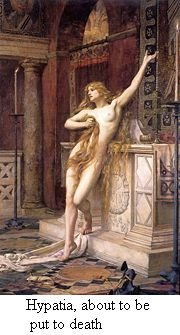
Hypatia was close friends with the prefect (secular governor) of Alexandria, Orestes. In the year 412, the bishop Theophilus died. His nephew Cyril took his place as the patriarch of Alexandria. Cyril was determined to wrest all power away from Orestes. Hypatia was caught in the middle of this political struggle. In the year 415, a Christian mob led by Peter the Reader dragged her from her carriage as she was returning home. They took her to the church called Caesareum, stripped her naked, and tore her flesh apart with tiles or oyster shells. They took her mangled body to a place called Cinaron and burnt it. Shortly thereafter, Orestes disappeared. The emperor took no action, apparently due to a bribe. Bishop Cyril became the sole ruler of Alexandria. The remaining scholars fled to Athens. Alexandria, once the intellectual light of the Western world, soon faded into mediocrity. Europe gradually descended into the Dark Ages.
Eleven hundred years later, Raphael was commissioned to
paint The School of Athens for Pope Julius II. The fresco was to be
painted above the philosophical section of the Pope's personal library.
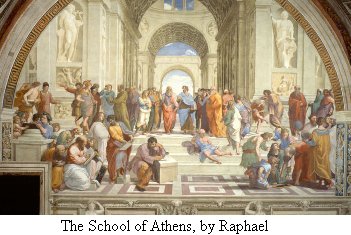 In his original draft, Raphael placed Hypatia in
the center, just below the central figures of Plato and Aristotle.
The church fathers ordered her removal. Raphael still managed to
sneak her into the fresco, however, disguised as another figure.
In his original draft, Raphael placed Hypatia in
the center, just below the central figures of Plato and Aristotle.
The church fathers ordered her removal. Raphael still managed to
sneak her into the fresco, however, disguised as another figure.
 Hypatia is the woman dressed in white in the lower left of the painting, looking
directly out at the viewer. Hypatia, once condemned by a church father,
now gazes out over the church fathers.
Hypatia is the woman dressed in white in the lower left of the painting, looking
directly out at the viewer. Hypatia, once condemned by a church father,
now gazes out over the church fathers.
The Significance of Hypatia
Hypatia and her father Theon played a pivotal role in human history. Together they fought to stop the world from descending into the Dark Ages. They were not successful in this, but their life's work ultimately played a crucial role in helping to bring about the Renaissance a thousand years later. "Renaissance" means rebirth – the Renaissance was the rebirth of the Hellenistic Age of Reason. Hypatia may very well have been history's greatest teacher.
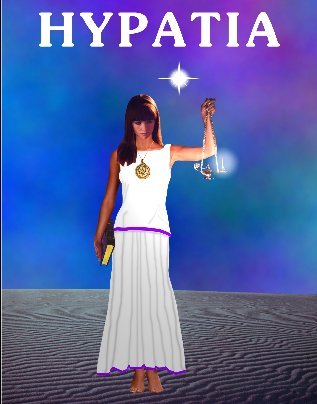
References
- Scholasticus, S. (c. 439). Ecclesiastical History. Book VII, Chapter 15.
- Deakin, M. A. B. (1994). Hypatia and Her Mathematics. The American Mathematical Monthly, 101(3), p. 236.
- Philostorgius (c. 425). Ecclesiastical History. Book VIII, Chapter 9.
- Synesius (402). Letter 15: A Hydrometer.
- Synesius (c. 405). On an Astrolabe.
- Deakin, M. A. B. (1994), p. 239.
- Deakin, M. A. B. (1994), p. 238.
- Damascius (c. 535). Lfe of Isadore, reproduced in The Suda (c. 975).
- Boyer, C. B. (1991). A History of Mathematics (2nd ed.). New York, NY: John Wiley & Sons, p. 190.
- Boyer, C. B. (1991), p. 119.
- Boyer, C. B. (1991), p. 391.